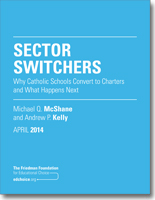Study: Why Catholic schools have “switched” to charter schools
For decades, Catholic schools, particularly inner-city Catholic schools, have seen declines in enrollment and an increasing need for subsidies from their dioceses. Many dioceses, however, have been unable to shoulder that burden, forcing schools to close. In response to difficult financial circumstances, the archdioceses of Indianapolis, Miami, and Washington, D.C., put a new twist on the typical story, “closing” a set of their inner-city schools, but allowing them to reopen as independently managed public charter schools.
That phenomenon raises interesting questions about the future of urban Catholic schooling. In this paper, we examine, both qualitatively and quantitatively, the effect of this conversion on the schools and communities involved.
By tracking enrollment information from before and after the conversion for both schools that switched as well as schools with similar demographics, we are able to conclude:
- Switching from private to charter significantly increased enrollment in affected schools.
- Switching from private to charter meaningfully increased the percentage of minority students in the schools.
Through interviews with key personnel in those school systems, we discovered several interesting implications from the decision to convert schools.
The question of what to do with struggling inner-city Catholic schools is still an open one. Evidence in the academic literature, confirmed by the lived experiences of the school leaders we interviewed, makes a strong case that private school choice programs can stem the tide of private school closures. But, as more communities consider school choice (both public and private) as a policy to give more options to low-income families, it is important to emphasize that how those programs are structured affects the schools that will be able to participate—and ultimately the set of choices available to families.



